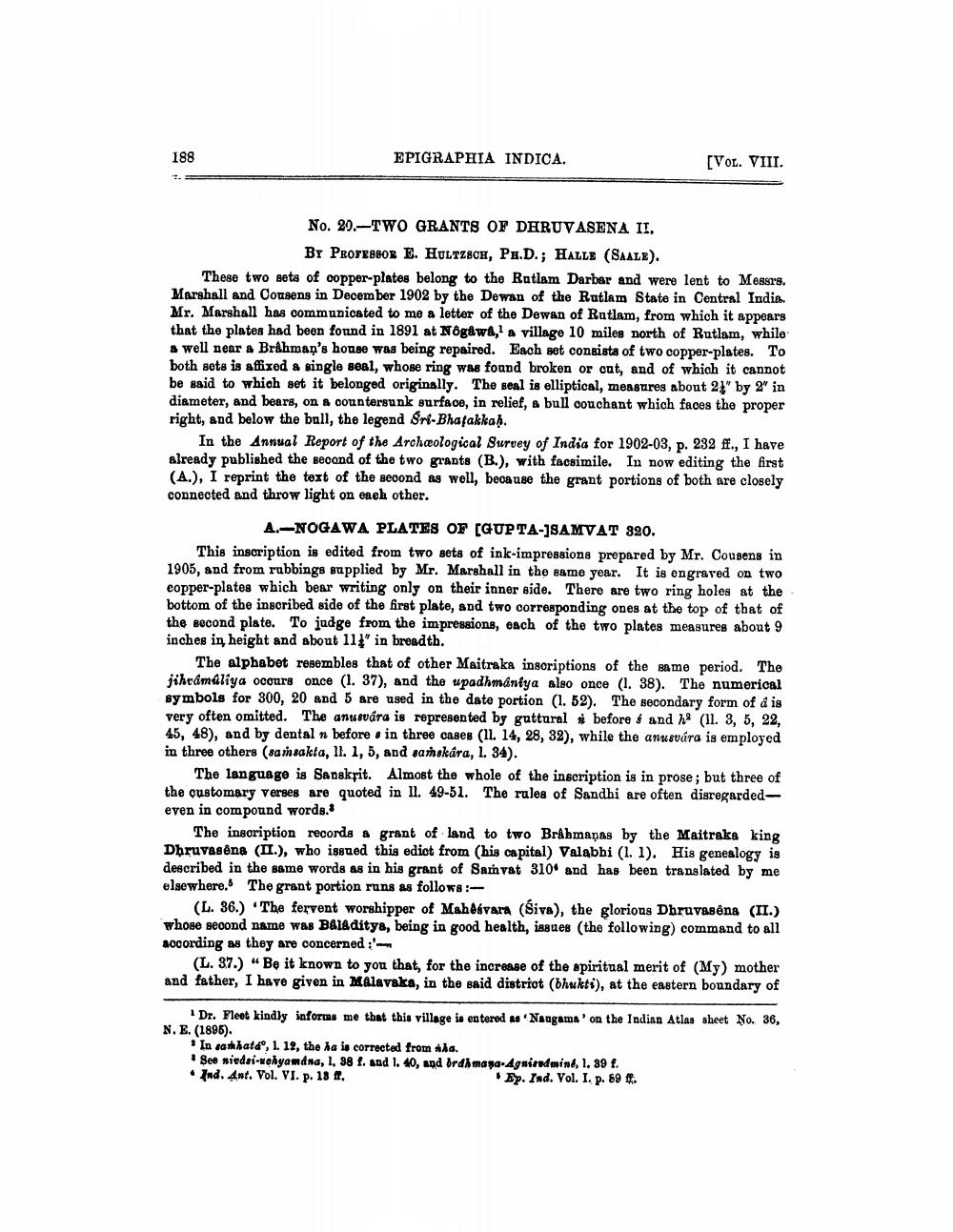________________
188
EPIGRAPHIA INDICA.
[Vol. VIII.
No. 20.-TWO GRANTS OF DHRUVASENA II.
BY PROFESSOR E. HULTZ8CH, PH.D.; HALLE (SAALE). These two sets of copper-plates belong to the Ratlam Darbar and were lent to Messrs. Marshall and Cousens in December 1902 by the Dewan of the Rutlam State in Central India. Mr. Marshall has communicated to me a letter of the Dewan of Ratlam, from which it appears that the plates had been found in 1891 at Nôgåwå, a village 10 miles north of Rutlam, while a well near a Brahman's house was being repaired. Each set consists of two copper-plates. To both sote is affixed a single seal, whose ring was found broken or cut, and of which it cannot be said to which set it belonged originally. The goal is elliptical, measures about 21" by 2" in diameter, and bears, on a countersunk surface, in relief, a bull couchant which faces the proper right, and below the bull, the legend Sri-Bhatakkah.
In the Annual Report of the Archæological Survey of India for 1902-03, p. 232 ff., I have already published the second of the two grants (B.), with facsimile. In now editing the first (A.), I reprint the text of the second as well, because the grant portions of both are closely connected and throw light on each other.
A.-NOGAWA PLATES OF (GUPTA-]SAMVAT 320. This inscription is edited from two sets of ink-impressions prepared by Mr. Cousens in 1903, and from rubbings supplied by Mr. Marshall in the same year. It is engraved on two copper-plates which bear writing only on their inner side. There are two ring holes at the bottom of the inscribed side of the first plate, and two corresponding ones at the top of that of the second plato. To judge from the impressions, each of the two plates measures about 9 inches in height and about 11 in breadth.
The alphabet resembles that of other Maitraka insoriptions of the same period. The jihrámúliya occurs once (1. 37), and the upadhmaniya also once (1. 38). The numerical symbols for 300, 20 and 5 are used in the date portion (1. 52). The secondary form of a is very often omitted. The anusuára is represented by guttural before and h* (11. 3, 5, 22, 45, 48), and by dental n before in three cases (11, 14, 28, 32), while the anusvára is employed in three others (sar sakta, ll. 1, 5, and sarokára, 1. 34).
The language is Sanskrit. Almost the whole of the inscription is in prose; but three of the customery verses are quoted in 11. 49-51. The rules of Sandhi are often disregarded - even in compound words.
The inscription records & grant of land to two Brahmaņas by the Maitraks king Dhruvasêng (II.), who issued this edict from (his capital) Valabbi (1.1). His genealogy is described in the same words as in his grant of San vat 310* and has been translated by me elsewhere. The grant portion runs as follows:
(L. 36.) The fervent worshipper of Mahdsvara (siva), the glorious Dhruvasêna (II.) whose second name was Bal&ditys, being in good health, issues (the following) command to all according as they are concerned :'
(L. 37.) “Be it known to you that, for the increase of the spiritual merit of (My) mother and father, I have given in Málavaka, in the said distriot (bhukti), at the eastern boundary of
Dr. Fleet kindly informs me that this village is entered Naugama' on the Indian Atlas sheet No. 36, N. E. (1895)
* In cashbatd, 1. 12, the ha is corrected from tha. * See niedai-sohyandna, 1, 38 f. and 1. 40, and ord maya-4gninndwind, 1. 89 f. • Ind. Ant. Vol. VI. p. 18 f.
Bp. Ind. Vol. I. p. 89.




